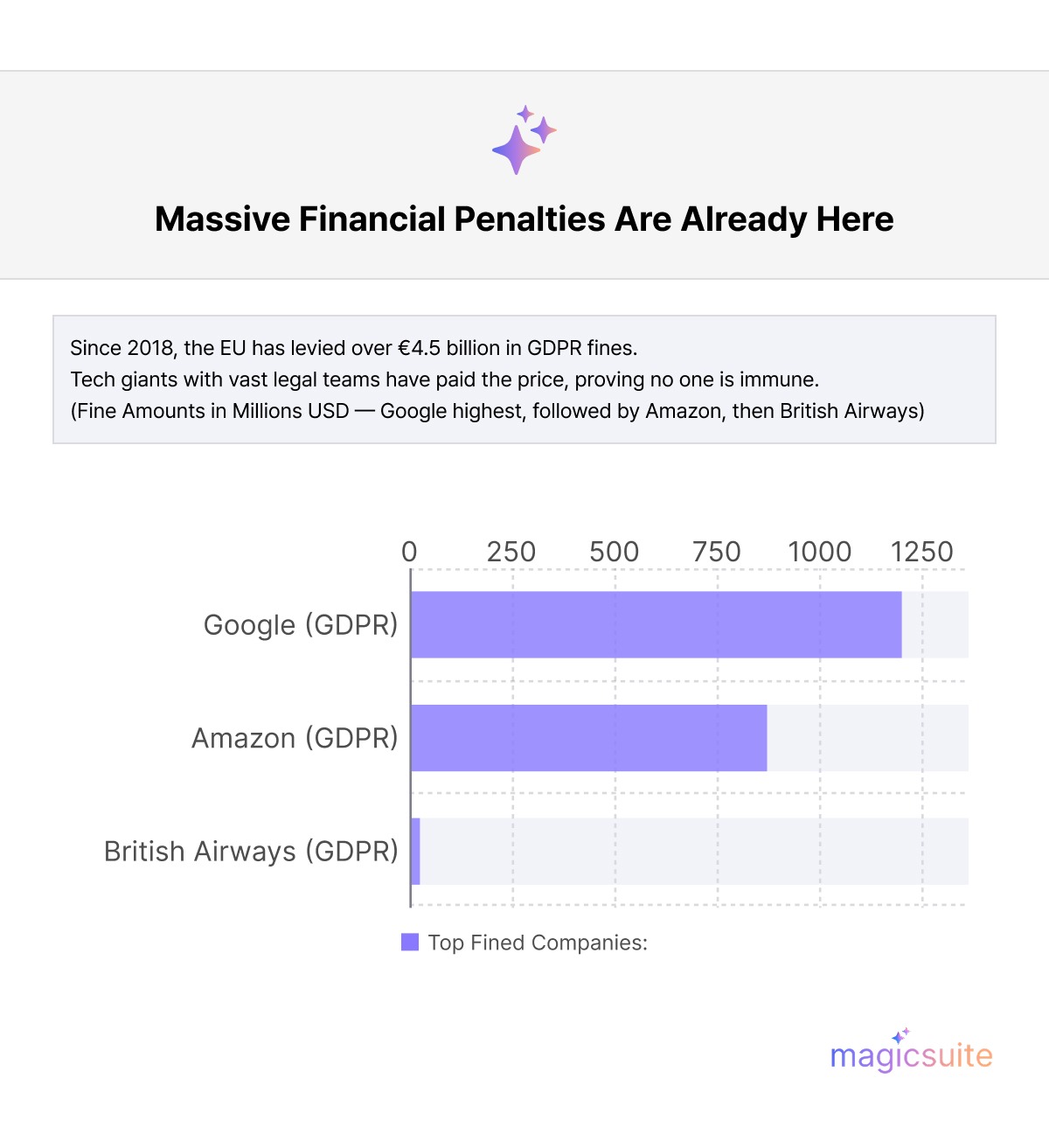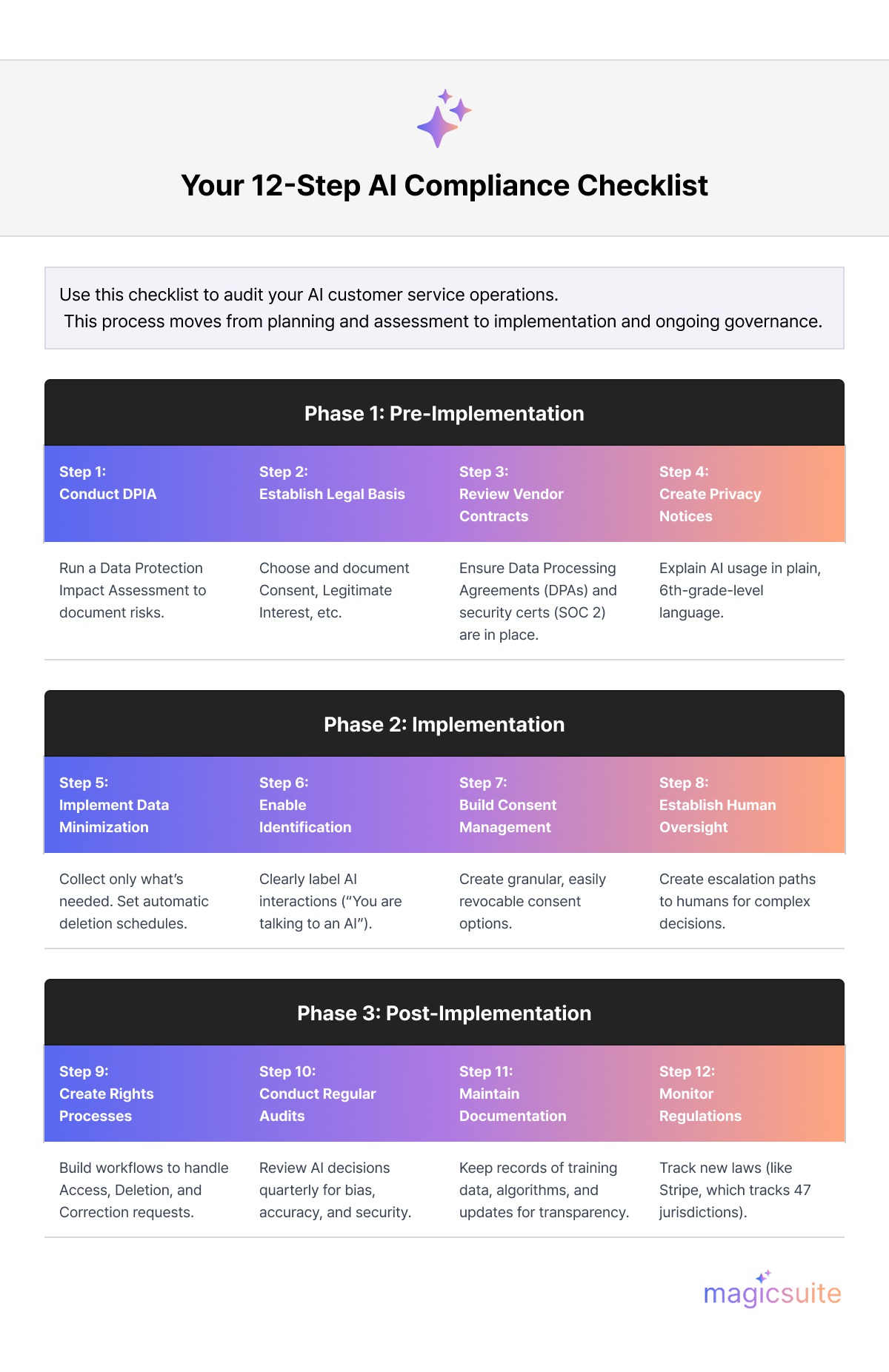Navigate AI compliance with confidence. Learn GDPR, CCPA requirements, and best practices for ethical AI in customer experience. Includes compliance checklist for CX leaders.

87% of companies using AI in customer service are currently non-compliant with at least one central data privacy regulation. That's not a typo. Nine out of ten businesses are unknowingly putting themselves at risk of massive fines, lawsuits, and reputation damage. The European Union has already levied fines totaling over €4.5 billion under the GDPR since 2018. Amazon paid $877 million. Google faced a $1.2 billion penalty. These aren't small startups—these are tech giants with entire legal departments.

If you're a CX leader implementing AI tools, you're standing at a critical crossroads. The AI revolution promises incredible customer experiences. But one compliance misstep can cost you everything you've built. This guide will show you exactly how to navigate AI compliance and keep your customer data safe. You'll walk away with a practical checklist, real examples, and the confidence to implement AI the right way.
In 2023 alone, over 50 new AI-related regulations were proposed globally. The EU AI Act, set to be fully enforced by 2026, creates the world's first comprehensive AI regulatory framework.
Here's what's at stake:
Companies like British Airways learned this the hard way. Their 2018 data breach resulted in a £20 million fine and immeasurable brand damage. The culprit was an inadequate security measure in their customer service systems.
AI governance and compliance aren't optional anymore. It's a business imperative. The regulations fall into three main categories:

Microsoft invested over $1 billion in compliance infrastructure for its Azure AI services. Salesforce created an entire "AI Ethics" division.
Let's break down what AI regulatory compliance actually means for your customer experience operations.
Before your AI touches any customer data, you need a legal justification. GDPR recognizes six lawful bases, but for CX operations, you'll typically rely on:
Consent: Customers explicitly agree to AI processing their data. Shopify's AI chatbot displays a clear consent banner before conversations begin. It's transparent, specific, and revocable.
Legitimate Interest: You have a valid business reason, and customer rights don't override it. Zendesk balances this by using AI for ticket routing while allowing customers to opt out at any time.
Contractual Necessity: Processing is required to deliver the service. When Netflix uses AI to recommend shows, it's part of their service contract.
Don't assume one consent covers everything. It doesn't. If you collect data for support tickets, you can't automatically use it for marketing AI without new permission.
Collect only what you need. Use it only for stated purposes. Sounds simple, but it's where most companies fail.
Bad example: Collecting customer birthdays, income, and browsing history to answer a shipping question.
Good example: HubSpot's AI chatbot requests only a name, an email address, and the specific issue—nothing more.
Spotify demonstrates purpose limitation perfectly. Their customer service AI accesses listening history only when troubleshooting playback issues. Marketing teams can't touch that data without explicit consent.
Customers have the right to know when they're interacting with AI. They also deserve to understand how decisions are made. The EU AI Act categorizes AI systems by risk level. High-risk systems (such as those that make credit decisions) face strict transparency requirements. Customer service AI typically falls into lower-risk categories, but transparency builds trust.
Zappos does this well: Their AI chat clearly identifies itself as "Zappos AI Assistant" and offers human transfer options immediately. They explain that their AI uses past purchase history to provide personalized help.
Apple goes further: Their privacy labels show exactly what data each AI feature uses and why. It's like nutrition labels for your data.
A 2024 Gartner study found that 73% of customers prefer transparent AI interactions over hidden ones—even if the AI is less sophisticated.
Your AI systems must protect customer data with appropriate technical and organizational measures.
Encryption is baseline: Data at rest and in transit must be encrypted. Amazon Web Services uses AES-256 encryption for all customer data processed by its AI services.
Access controls matter: Implement role-based access. Only authorized team members should access customer data. Slack's AI features use a zero-knowledge architecture—neither Slack nor anyone else can read your messages.
Regular audits are required: IBM conducts quarterly AI security audits across all customer-facing systems. They test for vulnerabilities, data leakage, and unauthorized access. Target's 2013 breach (affecting 41 million customers) happened because third-party vendors had excessive access. Don't make that mistake with your AI vendors.
Regulations grant customers specific rights over their data. Your AI systems must honor them:
Right to Access: Customers can request access to the data you hold. You have 30 days (GDPR) or 45 days (CCPA) to respond.
Right to Deletion: Also known as the "right to be forgotten." When requested, you must delete customer data unless you have a legitimate reason to retain it.
Right to Rectification: Customers can correct inaccurate data. Your AI must use updated information immediately.
Right to Object: Customers can refuse AI processing. You must provide non-AI alternatives.
Right to Explanation: For automated decisions, customers can ask "why?" Your AI must provide meaningful explanations.
Airbnb built a self-service portal where customers manage all these rights themselves. It reduced manual requests by 60% and improved compliance response times by 80%.
Experience the magic of compliant AI customer experience
Building compliant AI systems is complex. That's why we created MagicTalk—the AI customer service platform that makes compliance effortless while delivering exceptional customer experiences.
Built-in Compliance Framework: MagicTalk includes built-in GDPR, CCPA, and HIPAA-compliant features: no expensive consultants or months of configuration. Our AI governance and compliance tools handle the heavy lifting automatically.
Transparent AI Interactions: Every conversation clearly identifies AI involvement. Customers always know when they're chatting with our intelligent assistant, and human escalation is always one click away.
Data Minimization by Design: Our AI accesses only the data needed for each conversation. No unnecessary collection. No data fishing expeditions. Just focused, purposeful interactions.
Privacy-First Architecture: We use advanced encryption, secure data handling, and regular third-party audits. Your customer data stays protected—and compliant—at every step.
Customer Rights Automation: MagicTalk automatically handles access, deletion, and data portability requests. What used to take your team hours now happens in minutes.
Explainable AI: Our system provides clear reasoning for every recommendation and decision. No black boxes. No mysterious algorithms. Just transparent, trustworthy AI.
Put AI to work for you—compliantly and confidently.
Get started with MagicTalk and discover a new way of working with AI.
Related read: Can AI Deliver Empathy in Customer Service?
Use this checklist to audit your current AI customer service operations. Each item represents a critical compliance requirement.

1. Conduct a Data Protection Impact Assessment (DPIA)
2. Establish Legal Basis for Processing
3. Review AI Vendor Contracts
4. Create Transparent Privacy Notices
5. Implement Data Minimization
6. Enable Customer Identification Systems
7. Build Consent Management
8. Establish Human Oversight
9. Create Rights Response Processes
10. Conduct Regular Audits
☐11. Maintain Comprehensive Documentation
12. Monitor Regulatory Changes
Even well-intentioned companies make these errors. Learn from their experiences:

What happened: A healthcare provider deployed an AI chatbot in 2019. They never updated it. By 2023, it had violated three new state privacy laws.
The cost: $2.3 million in fines and remediation costs.
How to avoid it: Schedule quarterly compliance reviews. Regulations change constantly. Your AI systems must evolve, too.
What happened: A retail company used "legitimate interest" to justify AI analysis of customer photos without consent.
The cost: €10 million GDPR delicate and massive PR backlash.
How to avoid it: When in doubt, get consent. Legitimate interest has a high bar—customer rights often override it.
What happened: A financial services firm used a third-party AI vendor. The vendor had poor security. Customer data leaked.
The cost: The Company faced the fines and lawsuits, not the vendor.
How to avoid it: Treat AI vendors like employees. Do thorough background checks. Verify their certifications. Review their security practices.
What happened: An AI recruiting tool systematically discriminated against specific demographics. The company faced a class-action lawsuit.
The cost: $8 million settlement plus incalculable reputation damage.
How to avoid it: Regularly audit AI outputs for bias. Test across diverse data sets. Implement fairness metrics.
What happened: A SaaS company kept all customer interaction data indefinitely "just in case." Regulators found it excessive.
The cost: Required to delete 10 years of data and pay €500,000 fine.
How to avoid it: Set retention schedules. Keep data only as long as necessary. Delete it when the purposes are fulfilled.
Compliance isn't just about rules and checklists. It's about organizational culture.
The regulatory landscape will only get stricter. Here's what's coming:
Companies preparing now will dominate. Those waiting will scramble to catch up.
Don't wait for a compliance crisis. Start now:
AI compliance doesn't have to be overwhelming. With the right tools and mindset, you can deliver exceptional customer experiences while respecting privacy and following regulations.
MagicTalk makes this easy. Our platform combines powerful AI capabilities with built-in compliance features. You don't need to be a privacy lawyer to use AI responsibly.
Ready to transform your customer experience—the compliant way?
Discover MagicTalk and harness the power of AI without the compliance headaches. Your customers deserve both innovation and protection. We help you deliver both.
Additional Resources:
The future of customer experience is AI-powered. The future of AI is compliant, ethical, and transparent. Make sure you're on the right side of both.

Hanna is an industry trend analyst dedicated to tracking the latest advancements and shifts in the market. With a strong background in research and forecasting, she identifies key patterns and emerging opportunities that drive business growth. Hanna’s work helps organizations stay ahead of the curve by providing data-driven insights into evolving industry landscapes.